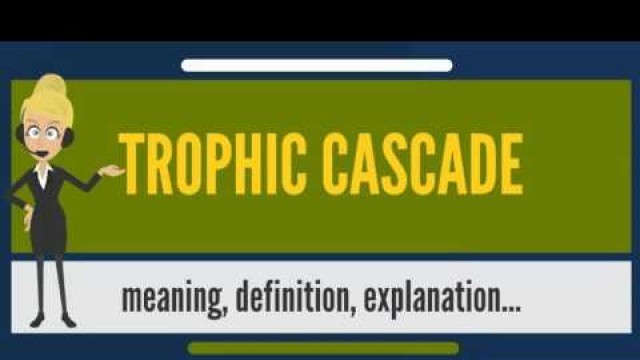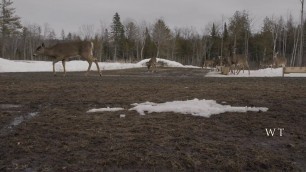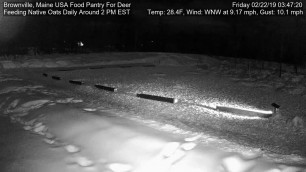

'✪✪✪✪✪ http://www.theaudiopedia.com ✪✪✪✪✪ What is TROPHIC CASCADE? What does TROPHIC CASCADE mean? TROPHIC CASCADE meaning - TROPHIC CASCADE definition - TROPHIC CASCADE explanation. Source: Wikipedia.org article, adapted under https://creativecommons.org/licenses/by-sa/3.0/ license. Trophic cascades occur when predators in a food web suppress the abundance or alter the behavior of their prey, thereby releasing the next lower trophic level from predation (or herbivory if the intermediate trophic level is a herbivore). For example, if the abundance of large piscivorous fish is increased in a lake, the abundance of their prey, smaller fish that eat zooplankton, should decrease. The resulting increase in zooplankton should, in turn, cause the biomass of its prey, phytoplankton, to decrease. The trophic cascade is an ecological concept which has stimulated new research in many areas of ecology. For example, it can be important for understanding the knock-on effects of removing top predators from food webs, as humans have done in many places through hunting and fishing. A top-down cascade is a trophic cascade where the food chain or food web is disrupted by the removal of a top predator, or a third or fourth level consumer. On the other hand, a bottom-up cascade occurs when a primary producer, or primary consumer is removed, and there is a reduction of population size through the community. An example could include Paine\'s study from the University of Washington, where he removed several species in different plots along the North-Western United States coast line, and realized that Pisaster, a common starfish, when removed, created a top-down cascade which involved a surge in barnacle and mussel populations, but a decrease in the populations of chitons, limpets, and whelks. This led to the conclusion that Pisaster was a keystone species in that food web. Aldo Leopold is generally credited with first describing the mechanism of a trophic cascade, based on his observations of overgrazing of mountain slopes by deer after human extermination of wolves. Nelson Hairston, Frederick E. Smith and Lawrence B. Slobodkin are generally credited with introducing the concept into scientific discourse, although they did not use the term either. Hairston, Smith and Slobodkin argued that predators reduce the abundance of herbivores, allowing plants to flourish. This is often referred to as the green world hypothesis. The green world hypothesis is credited with bringing attention to the role of top-down forces (e.g. predation) and indirect effects in shaping ecological communities. The prevailing view of communities prior to Hairston, Smith and Slobodkin was trophodynamics, which attempted to explain the structure of communities using only bottom-up forces (e.g. resource limitation). Smith may have been inspired by the experiments of a Czech ecologist, Hrbáček, whom he met on a United States State Department cultural exchange. Hrbáček had shown that fish in artificial ponds reduced the abundance of zooplankton, leading to an increase in the abundance of phytoplankton. Hairston, Smith and Slobodkin argued that the ecological communities acted as food chains with three trophic levels. Subsequent models expanded the argument to food chains with more than or fewer than three trophic levels. Lauri Oksanen argued that the top trophic level in a food chain increases the abundance of producers in food chains with an odd number of trophic levels (such as in Hairston, Smith and Slobodkin\'s three trophic level model), but decreases the abundance of the producers in food chains with an even number of trophic levels. Additionally, he argued that the number of trophic levels in a food chain increases as the productivity of the ecosystem increases. Although the existence of trophic cascades is not controversial, ecologists have long debated how ubiquitous they are. Hairston, Smith and Slobodkin argued that terrestrial ecosystems, as a rule, behave as a three trophic level trophic cascade, which provoked immediate controversy. Some of the criticisms, both of Hairston, Smith and Slobodkin\'s model and of Oksanen\'s later model, were: 1. Plants possess numerous defenses against herbivory, and these defenses also contribute to reducing the impact of herbivores on plant populations. 2. Herbivore populations may be limited by factors other than food or predation, such as nesting sites or available territory. 3. For trophic cascades to be ubiquitous, communities must generally act as food chains, with discrete trophic levels. Most communities, however, have complex food webs. In real food webs, consumers often feed at multiple trophic levels (omnivory), organisms often change their diet as they grow larger, cannibalism occurs, and consumers are subsidized by inputs of resources from outside the local community, all of which blur the distinctions between trophic levels.'
Tags: english vocabulary , vocabulary , trophic cascade , dictionary , english dictionary , online dictionary , online vocabulary , how to pronounce words , what do words mean , what is trophic cascade , trophic cascade meaning , trophic cascade definition , trophic cascade explanation , what is the meaning of trophic cascade , what is the definition of trophic cascade , what does trophic cascade mean , what does trophic cascade stand for
See also:












!['\"El videoclip en clase de Francés\" [8vo HCS 2] - \"Sénégal Fast Food\"'](https://cdn-img01.recipeaboutfood.com/images/50-m/769/769449_m.jpg)




comments